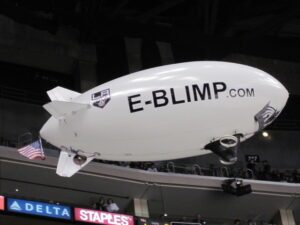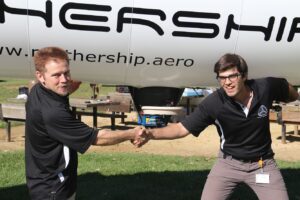
Most of us in the drone industry can agree that it’s the data – not the aircraft – that provides value. But what if the aircraft is a blimp instead of a drone? DRONELIFE spoke with Jonathan Nutzati, CEO of Mothership Aeronautics about his recent announcement of merging with eBlimp, the marketplace, and what they are up to on the Mothership.
DroneLife: Tell our readers who may not familiar with Mothership and eBlimp what the company does.
Jonathan Nutzati: “We are taking some of the cutting-edge drone technology that has become accessible to developers over the past 5 years, putting it into a mature advertising blimp design, adding our own lightweight solar panels and integrating them to produce a long-endurance data collection solution.”

DroneLife: There seems to be two product lines, one for commercial applications and one focused on advertising and media events. How did that happen and why the different product sets?
Jonathan Nutzati: “When I first started Mothership Aeronautics, I was looking for a balloon I could use as a starting point for my prototype. I found eBlimp on Google and got in touch with the owner, Larry Fleming. We had a Skype call in which I told him what we’re intending to do with the blimp we were buying from him, and he said he was also trying to develop a solar powered blimp.
Our early collaboration went well and within 3 months we were able to successfully demonstrate a functioning solar powered prototype.

While eBlimps were a high-performing, light-weight and effective blimp platform, they were not equipped with GPS and autopilot or the types of payloads typically used in commercial asset inspections. eBlimp had been around since 2004, while the drone inspection wave didn’t come up until 2011, the eBlimps had not been targeted to that kind of customer.
My market research that I did when I first developed Mothership’s business plan led me to two specific niches in the drone inspection market that would fit comfortably with our core competencies, long-linear infrastructure and persistent surveillance. We dedicated ourselves to the commercial inspection in those niches.
While there is some overlap in capability between the advertising blimps and the inspection blimps, we found that our training programs and product configurations were different, and our clients had different budgets and priorities. Before the merger, this serves as a good division to ensure eBlimp could supply blimps to Mothership without fear of competition, but it remains a good separation in our marketing even after the merger.”

DroneLife: How did you come up with the name Mothership?
Jonathan Nutzati: “I was having a pancake breakfast with my buddy after surviving a crazy, dangerous hang glider experiment in Half-Moon Bay, California. We started shooting around creative ideas for a new startup involving solar-powered aviation and somehow the idea came up to use a solar-powered airship as an aircraft carrier for carrying and charging small drones.
Drawing inspiration from Science Fiction, I decided that such a craft would be called the Drone Mothership and that it would be worth building – so I founded Mothership Aeronautics the next day.”

DroneLife: You recently merged the two companies, can you tell us more about that?
Jonathan Nutzati: “In 2017 after we raised an early VC funding round of $300,000, Mothership focused on providing a service to the energy pipeline industry. Our plan was to buy eBlimps from eBlimp and convert them to be Mothership Pipeline inspection blimps by integrating solar, autopilot and payloads.
Although Mothership invested heavily into tackling the pipeline industry, the value proposition for unmanned solar blimps was equally promising for other industries like border patrol, highway construction and mining exploration. We were finding that an aircraft with the same specifications could do most of it, but the business and data processing side of offering an inspection service was very specialized.

We saw that the change in the drone industry where big companies realized that the people flying the drone and analyzing their data should be someone from their own industry, ideally even the person who was doing that job before the drone came along. Having a drone doesn’t automatically make you a mining expert, an agricultural expert a border control agent. Rather than try to replace professionals at what they do best, we’d should empower them with our technology.
Mothership’s original goal involved both developing a new technology, but also of sustainably deploying that technology at end-users. This was essentially two businesses. Mothership decided to take a step back from focusing on services, and to leave space for new partnerships to grow.
In order to reposition ourselves to sell the airships efficiently, we had to redo our supply chain and that involved a more long-term partnership with eBlimp.”

DroneLife: Who is using the advertising and event marketing blimps?
Jonathan Nutzati: “Some of our consistent clients in advertising have been sports teams, colleges, college sports teams, advertising agencies and concert producers. They work great for carrying large banners and artwork and dropping prizes and coupons over crowds.”
DroneLife: Do the blimps fall in the same category as drones under the FAA in the US? Do you need a waiver to fly over people?
Jonathan Nutzati: “As of now, all of the blimps we sell conform to part 107. Our 12m eBlimps and the Terrasoar come in just under 55lbs.
It’s possible to get an ‘Operations over people’ waiver using our aircraft, and the case is easy to make. Unlike with a multi rotor drone, if our airship were to lose power or control, it would not fall and cause damage or injury, rather it would gently float down to the ground. Even so, getting hit by a blimp is rather less painful or damaging than being hit by a volleyball.”
DroneLife: What other world markets are you involved in?
Jonathan Nutzati: “We are working on some cool projects with our investors and partners the Philippines and in Chile involving publicity and aerial support for various primary industries and natural resource stakeholders. We hope to continue to grow and focus on the South American and South East Asian markets.”

DroneLife: In the commercial segment, how long and what range can one of the commercial units cover?
“Our solar Scout and Terrasoar can each fly around 8 hours in daylight. We currently offer various communications packages ranging up to 20 miles in the best conditions. As far as electric powerplants go, this is on the higher end. Most of our customers are looking for this capability specifically when they decide to work with us.”
DroneLife: Who do you compete against and why are you different?
Jonathan Nutzati: “Companies like Aerovironment, Harris and Insitu, the people making and operating $500,000 – $2,000,000 UAS. They were able to fly very profitably before 107 under exemption and had the market to themselves.”
DroneLife: Looking forward, which drone sectors do you seem having the most traction?
Jonathan Nutzati: “With the success of China’s One Belt One Road program, we have entered the age of large intercontinental infrastructure projects. Intercontinental long-linear inspection and asset management is now more critical than ever, and unmanned technology will be used to help manage that.”
DroneLife: Who is your targeted client?
Jonathan Nutzati: “They are typically companies of 3-20 individuals, a mix of civil engineers, surveyors, construction project managers and inspectors. They’re flying UAS worth $5,000 – $30,000 on projects for $5,000 – $20,000. They’re contracting for big farms, mines, logging companies, energy and infrastructure companies and the government. Some of their clients are asking them to do more ambitious collection missions, but the regulatory environment and the limitations of their technology are making these challenging or unprofitable. They are looking for a platform that can help them to overcome this and take that next step.”
DroneLife: What will be next for the new venture?
Jonathan Nutzati: “Once we’ve ramped up Terrasoar production and released an autopilot upgrade for existing eBlimp products, we’ll return to building the flying aircraft carrier for drones.
DroneLife: What are the corporate goals for 2019?
Jonathan Nutzati: We want to produce a distributor network to support global sales and blimp training.
We are working on modularizing our blimp training so that it can be offered online or by our distributors locally at the customer’s venue. Right now, we combine our free training with delivery, instead of paying for shipping a blimp, our clients will fly our instructors to their site where training is provided upon delivery. We are then limited by how much of the training each client can absorb in that one session.
We are expanding our production teams accordingly to support such a global network and make sure all of our distributors can have enough product in inventory to support short lead times and effective deployments.”
DroneLife: What question do you wish that I had asked but didn’t?
Jonathan Nutzati: “On which other planets do you intent to market your airships?
I recently learned from a NASA video, that at around 80,000ft altitude on Venus, Earth-air is buoyant, and the ambient temperature is only about 80 degrees Celsius. This makes buoyant airships an ideal platform for Venus colonization. I’ve been a Mars colonization my whole life, but that revelation was life changing, as I’d never seen venus as a real option due to its corrosive and inhospitable surface.
Venus remains an active, living planet and it’s much closer to Earth than Mars is. I believe that there is good potential for us to push our product line extraterrestrial in the long run. Would you live on a Mothership on Venus in 10 years?”
Have a taste for blimps? You can read more about blimps for indoor usage from our previous coverage here.
CEO DroneLife.com, DroneRacingLife.com, and CMO of Jobfordrones.com. Principle at Spalding Barker Strategies. Has enjoyed working with and around the commercial drone industry for the last 10 years. Attendance and speaker at Industry Events such as Commercial UAV, InterGeo, Interdrone and others. Proud father of two. Enjoys karate, Sherlock Holmes, and interesting things. Subscribe to all things drone at DroneLife here. Email is Harry@dronelife.com. Make Sure that you WhiteList us in your email to make sure you get our Newsletter. Editor1@dronelife.com.







[…] DRONELIFE […]